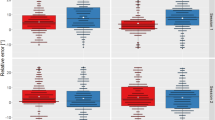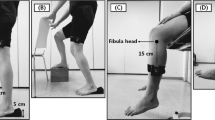Abstract
Background
Proprioception can be assessed by measuring joint position sense (JPS). Most studies have focused on JPS of the knee joint while literature for other joints especially for hip JPS is scarce. Although some studies have evaluated proprioception of the knee joint, the reproducibility of methods has rarely been investigated.
Aims
To estimate intrasession reliability and agreement of an active–active JPS test for hip flexion/abduction and knee flexion in healthy older adults.
Methods
Nineteen healthy older adults participated in this study. The proprioception of the hip (flexion and abduction) and knee (flexion) were assessed in both legs using the “active–active” reproduction technique. Intraclass correlation coefficient (ICC), standard error of measurement (SEM), and limits of agreement (LOA) were estimated for relative angular error (RE), absolute angular error (AE), and variable angular error (VE).
Results
Reliability of our JPS test was substantial to almost perfect for the RE for both joints and legs (ICC values ranging from 0.75 to 0.93). We also found that the ICC values for AE were substantial for knee flexion and hip abduction of the left and right leg. The ICC results of VE showed poor reliability for hip and knee joints. SEM and LOA values for hip abduction were generally lower than for hip and knee flexion, indicating lower measurement error or more precise scores for the proprioception test of hip abduction.
Conclusion(s)
Proprioceptive acuity of the knee and hip joints in healthy older adults can be reliably assessed with an active–active procedure in a standing position with respect to relative and absolute error.
Similar content being viewed by others
References
Sherrington CS (1906) The integrative action of the nervous system. Yale University, New Haven
Lord SR, Rogers MW, Howland A, Fitzpatrick R (1999) Lateral stability, sensorimotor function and falls in older people. J Am Geriatr Soc 47:1077–1081
Rogers MW, Mille M-L (2003) Lateral stability and falls in older people. Exerc Sport Sci Rev 31(4):182–187
Lonn J, Crenshaw A, Djupsjobacka M, Johansson H (2000) Reliability of position sense testing assessed with a fully automated system. Clin Physiol 20(1):30–37
Bullock-Saxton J, Wong W, Hogan N (2001) The influence of age on weight-bearing joint reposition sense of the knee. Exp Brain Res 136(3):400–406
Pai YC, Rymer WZ, Chang RW, Sharma L (1997) Effect of age and osteoarthritis on knee proprioception. Arthritis Rheum 40(12):2260–2265
Manchester D, Woollacott M, Zederbauer-Hylton N, Marin O (1989) Visual, vestibular and somatosensory contributions to balance control in the older adult. J Gerontol 44(4):118–127
Pickard CM, Sullivan PE, Allison GT, Singer KP (2003) Is there a difference in hip joint position sense between young and older groups? J Gerontol A Biol Sci Med Sci 58(7):631–635
Lord SR, Ward JA (1994) Age-associated differences in sensori-motor function and balance in community dwelling women. Age Age 23(6):452–460
Benjaminse A, Sell TC, Abt JP, House AJ, Lephart SM (2009) Reliability and precision of hip proprioception methods in healthy individuals. Clin J Sport Med 19(6):457–463
Olsson L, Lund H, Henriksen M, Rogind H, Bliddal H, Danneskiold-Samsøe B (2004) Test-retest reliability of a knee joint position sense measurement method in sitting and prone position. Adv Physiother 6(1):37–47
Kiefer G, Forwell L, Kramer J, Birmingham T (1998) Comparison of sitting and standing protocols for testing knee proprioception. Physiother Can 50(1):30–34
Andersen SB, Terwilliger DM, Denegar CR (1995) Comparison of open versus closed kinetic chain test positions for measuring joint position sense. J Sport Rehabil 4(3):165–171
Adamovich SV, Berkinblit MB, Fookson O, Poizner H (1998) Pointing in 3D space to remembered targets. I. Kinesthetic versus visual target presentation. J Neurophysiol 79:2833–2846
Felson DT, Gross KD, Nevitt MC, Yang M, Lane NE, Torner JC, Lewis CE, Hurley MV (2009) The effects of impaired joint position sense on the development and progression of pain and structural damage in knee osteoarthritis. Arthritis Care Res 61(8):1070–1076
Good L, Roos H, Gottlieb DJ, Renström PA, Beynnon BD (1999) Joint position sense is not changed after acute disruption of the anterior cruciate ligament. Acta Orthop 70(2):194–198
Kalaska JF (1994) Central neural mechanisms of touch and proprioception. Can J Physiol Pharmacol 72(5):542–545
Laufer Y, Hocherman S, Dickstein R (2001) Accuracy of reproducing hand position when using active compared with passive movement. Physiother Res Int 6(2):65–75
Boerboom A, Huizinga M, Kaan W, Stewart R, Hof A, Bulstra S, Diercks R (2008) Validation of a method to measure the proprioception of the knee. Gait Posture 28(4):610–614
Barrack RL, Skinner HB, Cook SD, Haddad RJ (1983) Effect of articular disease and total knee arthroplasty on knee joint-position sense. J Neurophysiol 50(3):684–687
Baker V, Bennell K, Stillman B, Cowan S, Crossley K (2002) Abnormal knee joint position sense in individuals with patellofemoral pain syndrome. J Orthop Res 20(2):208–214
Fouladi R, Nasseri N, Rajabi R, Geranmayeh M (2010) Joint position sense of the knee in healthy female athletes across the menstrual cycle. Koomesh 12(1):31–38
Arockiaraj J, Korula R, Oommen A, Devasahayam S, Wankhar S, Velkumar S, Poonnoose P (2013) Proprioceptive changes in the contralateral knee joint following anterior cruciate injury. Bone Joint J 95(2):188–191
de Vet HC, Bouter LM, Bezemer PD, Beurskens AJ (2001) Reproducibility and responsiveness of evaluative outcome measures. Int J Technol Assess Health Care 17(04):479–487
Shrout PE, Fleiss JL (1979) Intraclass correlations: uses in assessing rater reliability. Psychol Bull 86(2):420–428
Landis JR, Koch GG (1977) The measurement of observer agreement for categorical data. Biometrics 33:159–174
Bland JM, Altman DG (1999) Measuring agreement in method comparison studies. Stat Methods Med Res 8(2):135–160
Pincivero DM, Bachmeier B, Coelho AJ (2001) The effects of joint angle and reliability on knee proprioception. Med Sci Sports Exerc 33(10):1708–1712
Hurkmans E, Van Der Esch M, Ostelo R, Knol D, Dekker J, Steultjens M (2007) Reproducibility of the measurement of knee joint proprioception in patients with osteoarthritis of the knee. Arthritis Care Res 57(8):1398–1403
Piriyaprasarth P, Morris ME, Winter A, Bialocerkowski AE (2008) The reliability of knee joint position testing using electrogoniometry. BMC Musculoskelet Disord 9(1):6–16
Mendelsohn ME, Overend TJ, Petrella RJ (2004) Effect of rehabilitation on hip and knee proprioception in older adults after hip fracture: a pilot study. Am J Phys Med Rehabil 83(8):624–632
Rankin G, Stokes M (1998) Reliability of assessment tools in rehabilitation: an illustration of appropriate statistical analyses. Clin Rehabil 12(3):187–199
Lin C-H, Lien Y-H, Wang S-F, Tsauo J-Y (2006) Hip and knee proprioception in elite, amateur, and novice tennis players. Am J Phys Med Rehabil 85(3):216–221
Bennell K, Wee E, Crossley K, Stillman B, Hodges P (2005) Effects of experimentally-induced anterior knee pain on knee joint position sense in healthy individuals. J Orthop Res 23(1):46–53
Ishii Y, Terajima K, Terashima S, Bechtold JE, Laskin RS (1997) Comparison of joint position sense after total knee arthroplasty. J Arthroplast 12(5):541–545
Weir JP (2005) Quantifying test-retest reliability using the intraclass correlation coefficient and the SEM. J Strength Cond Res 19(1):231–240
Atkinson G, Nevill AM (1998) Statistical methods for assessing measurement error (reliability) in variables relevant to sports medicine. Sports Med 26(4):217–238
Duman I, Taskaynatan MA, Mohur H, Tan AK (2012) Assessment of the impact of proprioceptive exercises on balance and proprioception in patients with advanced knee osteoarthritis. Rheumatol Int 32(12):3793–3798
Song CH, Petrofsky JS, Lee SW, Lee KJ, Yim JE (2011) Effects of an exercise program on balance and trunk proprioception in older adults with diabetic neuropathies. Diabetes Technol Ther 13(8):803–811
Nallegowda M, Singh U, Handa G, Khanna M, Wadhwa S, Yadav SL, Kumar G, Behari M (2004) Role of sensory input and muscle strength in maintenance of balance, gait, and posture in Parkinson’s disease: a pilot study. Am J Phys Med Rehabil 83(12):898–908
Dover G, Powers ME (2003) Reliability of joint position sense and force-reproduction measures during internal and external rotation of the shoulder. J Athl Train 38(4):304–310
Acknowledgments
This research was funded by the European Commission through MOVE-AGE, an Erasmus Mundus Joint Doctorate programme (2011-0015). Mirjam Pijnappels was financially supported by a TOP-NIG Grant (No. 91209021) from the Dutch Organization for Scientific Research (NWO). The authors would like to thank Arjan de Zwart for his valuable assistance on data collection.
Conflict of interest
The authors declare that there are no conflicts of interest.
Author information
Authors and Affiliations
Corresponding author
Rights and permissions
About this article
Cite this article
Arvin, M., Hoozemans, M.J.M., Burger, B.J. et al. Reproducibility of a knee and hip proprioception test in healthy older adults. Aging Clin Exp Res 27, 171–177 (2015). https://doi.org/10.1007/s40520-014-0255-6
Received:
Accepted:
Published:
Issue Date:
DOI: https://doi.org/10.1007/s40520-014-0255-6




